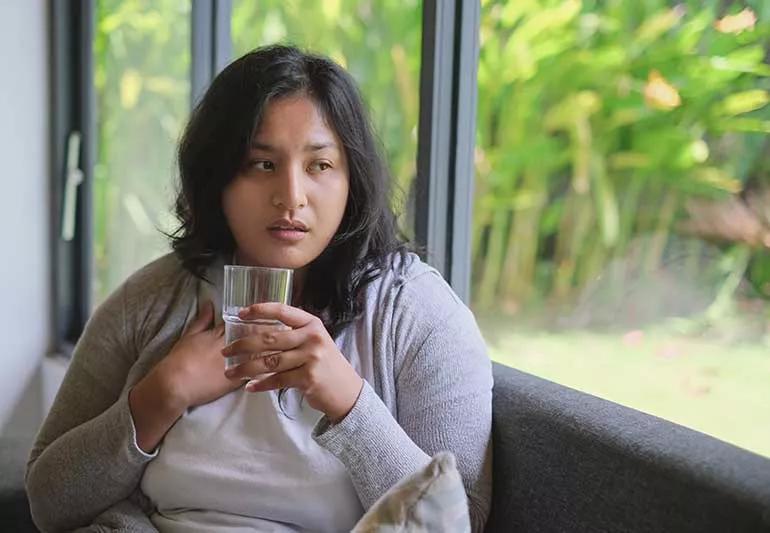From antiviral meds to preventive therapy, the options are greater than ever

Infections disease specialist Tricia Bravo, MD, points out that most of us have encountered COVID-19 by now, whether from an infection or being around someone who was sick. The virus that went global in 2020 is still very much with us thanks to its many variants, so more treatments and ongoing research are still needed.
Advertisement
Cleveland Clinic is a non-profit academic medical center. Advertising on our site helps support our mission. We do not endorse non-Cleveland Clinic products or services. Policy
Luckily, we’re in a much better place to fight it now than when the pandemic started. We have vaccines and boosters, which help reduce the need for hospitalization. And there are available treatment options to consider that can prevent serious infections and help you bounce back faster than before — even when you need to recover from home and aren’t yet sick enough to come into the hospital.
Dr. Bravo shares the latest updates on COVID-19 treatments. But she emphasizes that even with these additional medications for COVID-19, prevention (looking at you, vaccines and boosters) is still our best defense against disease.
About 80% of people who get sick with COVID-19 have a mild illness and can recover on their own. But even if your illness is “mild,” you can still feel pretty miserable. If this is you, here’s how to treat COVID-19 symptoms at home.
Stay home while you’re having symptoms, take it easy and drink plenty of fluids. Water is always the top choice for staying hydrated.
You may be wondering what medicine you can take for COVID-19. Start with your regular over-the-counter medicines like acetaminophen (Tylenol®) to ease headaches and body pain. These meds can also help lower a fever. Nonsteroidal anti-inflammatory drugs (NSAIDs) like ibuprofen (Advil® and Motrin®) can be taken instead if your symptoms don’t improve with acetaminophen.
Advertisement
If you’re not improving or you’re getting worse, Dr. Bravo advises keeping a close watch on symptoms. While rare, other illnesses can develop even with a mild case of COVID-19.
Some people with COVID-19 can end up with pneumonia, a lung infection. It may start mild or look similar to other illnesses, with symptoms like cough, fever and shortness of breath.
If you have serious symptoms like chest pain and trouble breathing, seek medical attention right away.
We know things change quickly and often. Over the course of the pandemic, new research has given insight into treatments that work and any potential side effects treatments may have. But as COVID-19 and its variants have continued to evolve, research has been ongoing to keep up with how the virus is changing and to find better treatments that are more effective.
For the most up-to-date information, the U.S. Food and Drug Administration (FDA) offers a list of treatments that have been given emergency use authorization (EUA) for treating COVID-19. The National Institutes of Health (NIH) continues to update its guidelines with new, effective treatments, alongside a list of old treatments that have become ineffective. And for people outside of the U.S., the World Health Organization (WHO) offers its own set of guidelines on which treatments are recommended.
These recommendations are generally consistent with one another, but there’s a lot of information to sift through. For the most part, these treatments are for people who:
High-risk groups eligible for these treatments include people with underlying medical conditions or other risk factors. You may be at high risk if you have:
And these are just a few examples of high-risk groups. You may also be considered high risk if you’re pregnant, over 65, have a compromised immune system or take immunosuppressant medications, says Dr. Bravo.
Healthcare providers may give you a combination of these treatments because “there is no magic bullet for COVID-19,” Dr. Bravo notes. But these treatments have all been shown to help individuals who are at higher risk for severe infections and reduce their chances of being hospitalized with severe COVID-19:
One of the dangers of a serious COVID-19 infection is having low oxygen levels in your blood. This causes low oxygen in your body’s tissues (hypoxia) and can cause damage to your brain and other organs.
Advertisement
If you have low oxygen levels and you’re hospitalized, you may need supplemental oxygen therapy to help you breathe through a cannula (a small tube that sits inside your nostrils) or a face mask. People with the most severe cases of COVID-19 who can’t breathe on their own may need a ventilator. This is a serious intervention that requires sedation. Being on a ventilator means an extended hospital stay and longer recovery times.
Commonly referred to as steroids, corticosteroids like dexamethasone or prednisone target the potentially dangerous lung inflammation that can happen with COVID-19. These medications are typically used only in severe cases and are given in the form of capsules, IV infusions or muscle injections.
Other anti-inflammatory medications like Olumiant™ (baricitinib) are also authorized by the FDA to help when inflammation increases.
Antiviral medications help your body fight off certain viruses. They help stop you from spreading the virus to others if you start taking them early enough once you’re infected. In relation to COVID-19, antiviral medications stop the virus from making copies of itself. By doing this, they reduce the chance of you getting more serious symptoms and being hospitalized. Antiviral treatments for COVID-19 include:
Advertisement
For now, antiviral medications are the most direct form of treatment, especially for high-risk individuals. Thanks to the national Test-To-Treat program, you can now get tested for COVID-19 by a healthcare provider and get a prescription for an antiviral all in one location if you’re eligible.
There are some restrictions to taking antiviral drugs. You have to take these medications within five to seven days of starting your symptoms, and you may have to stop some current medications you’re taking to avoid drug interactions. People who are under 18, pregnant or trying to become pregnant shouldn’t use this medication unless their healthcare provider has determined its benefits outweigh the risks of using it during their pregnancy. If you think you’re interested in taking antiviral treatments, talk to your healthcare provider to find out if they’re the right fit for you.
Sometimes, symptoms can quickly resurface just days after finishing your antiviral treatment. Commonly known as “Paxlovid rebound,” it can happen with Lagevrio and Veklury, too. Sometimes, you can even test positive for COVID-19 up to eight days after finishing treatment. This is fairly uncommon, but if this happens, you shouldn’t take an additional course of treatment, according to the U.S. Centers for Disease Control and Prevention (CDC). Instead, talk to your healthcare provider and continue to monitor for worsening symptoms.
Advertisement
The FDA has also given emergency use authorization for convalescent plasma therapy for people who have an immunosuppressive disease or are receiving immunosuppressive treatment. With convalescent plasma, you receive a donation of antibodies from someone who’s had COVID-19 in an effort to boost your own immunity and fight back against the virus.
When you’re exposed to an infection, your body makes specific proteins, called antibodies, that are designed to fight off that infection. When you no longer have that infection, your body continues to produce some of those antibodies in case the infection returns.
Monoclonal antibodies are lab-made antibodies that mimic what your natural antibodies are able to do, but they tend to work faster with more immediate results. Monoclonal antibodies are most often used as a form of targeted therapy for specific kinds of cancer, but they’ve also been used throughout the pandemic to help fight off COVID-19.
Some monoclonal antibody medications are no longer authorized for treatment in the U.S. because they are less effective against new variants and dominant strains like Omicron and XBB.1.5. As of March 2023, the monoclonal antibodies that are no longer authorized for treatment in the U.S. (but may be authorized in other areas outside of the U.S.) include:
Actemra® (tocilizumab) is currently a monoclonal antibody treatment authorized for emergency use by the FDA. People age 2 and older who are hospitalized, receiving systemic corticosteroids and require supplemental oxygen are able to have access to this treatment through an IV infusion. This medication doesn’t target the coronavirus directly, but it’s an anti-inflammatory that stops your immune system from becoming overreactive to the virus. This medication has also been used to treat other inflammatory conditions like rheumatoid arthritis.
COVID-19 is still dangerous, which means that COVID-19 vaccines will continue to be part of our lives as the frontline defense against the virus and its many variants.
“This is a vaccine-preventable illness,” states Dr. Bravo. “And vaccines have prevented millions of deaths worldwide since they became available.”
These days, the best way to protect yourself is to stay up to date with vaccinations. That means talking with your healthcare provider about which vaccines are right for you. They can answer any questions you have about vaccines so you can feel comfortable and confident in the decision you make.
Learn more about our editorial process.
Advertisement

Most can return to work or school when they’re symptom-free for 24 hours

Covering your mouth when you cough and staying home when you’re sick are a couple ways to help keep yourself and others COVID-free

This vital nutrient supports your health, but its role in COVID-19 prevention and treatment isn’t proven

Studies have shown promising results, but additional research is needed

Infection and inflammation can cause you to lose your voice and have other voice changes until you’re fully healed

A COVID-19 infection can bring on depression or anxiety months after physical symptoms go away

Just like the flu, COVID-19 continues to evolve every year with new and smarter variants

The latest omicron subvariants carry specific mutations that may allow the SARS-CoV-2 virus to be better at evading immune protection

The best parenting style balances enforcing rules and showing plenty of love

Tips include cutting back on sugar, focusing on exercise and managing stress

It can be harder to let go when you’ve invested time, energy and emotions — but it might be the healthier choice long term